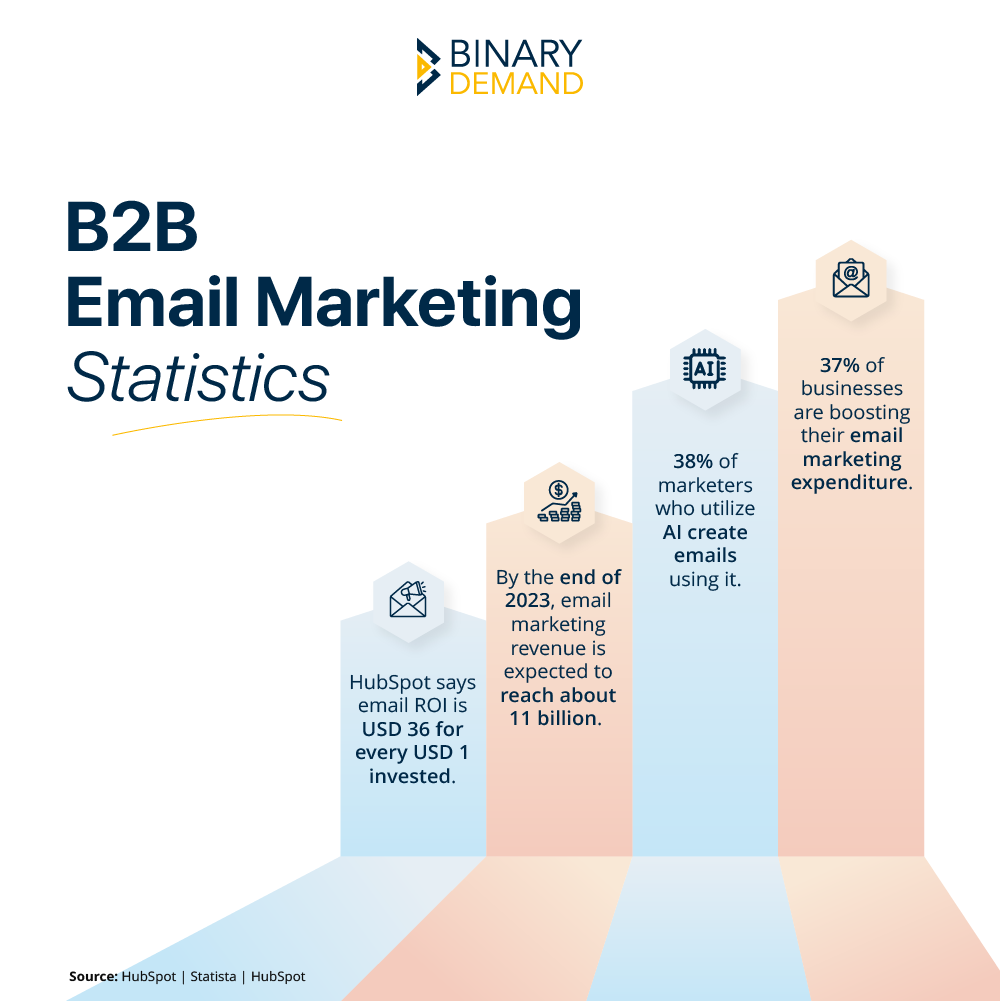
Email continues to dominate B2B marketing, but a generic approach isn’t enough. Success requires personalized, targeted messages that highlight your brand’s strengths. With its broad reach, affordability, and personal touch, B2B email marketing is essential for making a lasting impact on your audience.
Email marketing remains the reigning champion when it comes to successful B2B lead generation solutions and achieving higher conversion rates. This blog post delves into B2B email marketing, uncovering its vast potential and offering insights to leverage its power for business success. Discover the importance, functioning, and strategic elements to create impactful email campaigns that resonate with your B2B audience.
“Email marketing is the most effective tool for businesses to nurture leads and convert them into customers.” – Neil Patel, Digital Marketing Influencer
Get ready to unlock the untapped potential of B2B email marketing and pave the way for increased engagement, conversions, and business growth. Let’s dive in!
What is B2B Email Marketing?
B2B email marketing is a powerful digital marketing strategy tailored for business-to-business interactions. It involves sending targeted emails to businesses and professionals to establish and nurture relationships, generate leads, and drive conversions.
Moreover, B2B email marketing is designed to engage with decision-makers, stakeholders, and professionals in a corporate context.
B2B Email Marketing Statistics
This section of the blog will showcase some insightful stats hence proving why B2B email marketing is necessary for B2B organizations.

Why B2B Email Marketing Is Necessary
You might have a question – does email marketing work for B2B? The answer to your question lies in the statistics listed below.
Based on a recent Statista study, the global email marketing market was valued at USD 7.5 billion and is projected to reach USD 17.9 billion by 2027. This highlights the significant growth and undeniable opportunities B2B brands should embrace through email marketing. Additionally, here is a list of more reasons that shows the importance of a B2B email marketing strategy.
- Direct communication
- Cost-effective
- Targeted approach
- Relationship building
- Measurable results
- Automation and personalization
- Lead generation and conversion
B2B email marketing is necessary for effective and efficient communication, building relationships, generating leads, and driving business growth in the B2B space. Understanding why B2B email marketing is necessary provides the foundation to delve into how it works, enabling businesses to leverage its potential for effective communication, B2B lead generation, and ultimately achieve their marketing goals.
How Does Email Marketing Work?
Email marketing uses email as a communication channel to reach and engage your target audience. Here is an overview of how email marketing works:
- Building an Email List: First, develop a list of opt-in subscribers. Website sign-up forms, lead-generating efforts, and email content exchanges may do this.
- Selecting an Email Marketing Platform: Select a suitable email marketing platform. These systems help create, send, and manage email campaigns. They offer list management, automation, analytics, and tracking.
- Creating Email Campaigns: Use the platform’s drag-and-drop editor or HTML to create compelling email campaigns. Consider branding, personalization, interesting content, calls-to-action, and mobile responsiveness.
- Segmentation and Targeting: B2B email marketing segmentation is done from your email list based on relevant criteria such as demographics, interests, purchase history, or engagement level. This lets you deliver segment-specific emails that boost engagement and conversion.
- Scheduling and Sending Emails: Send emails at a suitable time and frequency. Schedule or automate your campaigns.
- Monitoring and Tracking: Track open rates, click-through rates, conversions, and unsubscribes for your email campaigns. This data helps you assess campaign performance and make data-driven improvements.
- Optimizing and Iterating: Analyze campaign outcomes and adapt. Optimize your email marketing approach by testing subject lines, content formats, calls-to-action, and other features.
- Compliance and Consent: Follow the GDPR and CAN-SPAM Act when email marketing. Respect subscriber consent and give explicit opt-out/preference alternatives.
By following these steps and consistently delivering valuable and relevant content to your subscribers, email marketing can be an effective tool for building relationships, driving engagement, generating leads, and, ultimately, achieving your marketing goals.
How to Build a B2B Email Marketing List
“Email marketing is like a fine wine—it gets better with time. Building a strong email list is an investment in the future success of your business.” – Amy Porterfield, Online Marketing Expert
Building a B2B email list is essential for successful email marketing. How to build an email list for B2B marketing is answered in detail in the below pointers:
- Create Valuable Content: Create valuable content like blog posts, e-books, whitepapers, or video tutorials, and use it to motivate visitors to subscribe to your email list.
- Use Opt-in Forms: Position opt-in forms prominently on your website, landing pages, and blog posts, with fields for email collection and optional details. Also, designs these forms to be simple, clear, and appealing.
- Offer Lead Magnets: Offer valuable lead magnets like e-books, checklists, templates, or industry reports in exchange for email addresses. Promote them on your website and social media.
- Use Pop-up Forms: Utilize pop-up forms on your website to engage visitors. Strategically employ exit-intent, timed, or scroll-triggered pop-ups to encourage subscriptions before they leave.
- Run Contests or Giveaways: Hold contests or giveaways that require participants to provide their email addresses. Advertise these promotions on your website, social media, and through paid ads to attract subscribers.
- Leverage Social Media: Use social media to promote your email newsletter. Create engaging posts, share exclusive content, and run ads with clear calls to action for subscribing.
- Optimize Landing Pages: Design landing pages with persuasive copy, captivating visuals, and a clear value proposition to capture email sign-ups effectively.
- Guest Blogging and Collaborations: Contribute guest posts to trusted websites or partner with influencers and industry experts. Add a call-to-action in the content or author bio to drive email list sign-ups.
- Offline Opportunities: Gather email addresses at events, trade shows, or in-store using physical sign-up forms or QR codes, highlighting the value subscribers will gain from joining your email list.
- Referral Programs: Implement a referral program where existing subscribers can refer friends or colleagues to join your email list. Incentivize referrals with exclusive content, discounts, or rewards.
- Keep in mind that growing an email list is a continuous effort. Prioritize value, transparency, and respect for subscriber preferences and privacy. Continuously monitor and optimize strategies to attract and retain valuable subscribers.
After building a B2B email list, prioritize email segmentation to optimize campaigns and send personalized messages to targeted subscriber groups.
Also Read: The Fundamentals of Email Marketing
What is Email Segmentation?
“A small list that wants exactly what you’re offering is better than a bigger list that isn’t committed.” – Ramsay Leimenstoll
Email segmentation involves categorizing your email subscribers into smaller, focused groups based on criteria like demographics, behavior, or preferences to enhance targeting and personalization. This helps you send more personalized and relevant content to each segment, improving the effectiveness of your B2B email marketing campaigns.
By segmenting your email list, you can customize your messages to better resonate with different subsets of your audience. This approach helps increase engagement, open rates, click-through rates, and conversions.
Some common segmentation criteria include:
- Demographic information: Segmenting is based on age, gender, location, or job title.
- Behavior and engagement: Segmenting based on previous interactions, purchase history, website activity, or engagement with past email campaigns.
- Preferences: Segmenting based on specific interests, preferences, or topics of interest indicated by subscribers.
- Customer lifecycle stage: Segmenting based on where subscribers are in their customer journeys, such as prospects, first-time customers, or loyal customers.
By sending more targeted and personalized content to each segment, you can deliver more relevant information, offers, and recommendations, leading to better engagement and higher conversion rates. Email segmentation allows your communication to be more effective and tailored to your subscribers’ unique needs and interests.
Conclusion
To enhance the impact of email campaigns, businesses can employ successful tactics like email segmentation, valuable content creation, optimized send times, and metric tracking.
Personalization and relevance are vital in engaging B2B audiences, achieved through segmenting the email list and tailoring content accordingly. Consistent analysis and optimization based on metrics like open rates, click-through rates, and conversions are essential for ongoing improvement.
B2B email marketing requires a personalized approach by understanding your audience, preferences, and journey. Moreover, crafting valuable emails leads to engagement, customer relationships, and successful conversions. Binary Demand understands that it is a crucial aspect of the business. Our team of experts will put your business on the right path.
FAQs:
Q. Is good B2B email marketing easy?
A. Good B2B email marketing requires strategy, planning, and continuous optimization. It’s not necessarily easy, but with the right approach and resources, it can be highly effective in generating results.
Q. Is B2B email optimization important?
A. Yes, email optimization is crucial for maximizing the effectiveness of your email marketing campaigns, improving engagement rates, and driving desired actions from your audience.
Q. Which is regarded as the best time to send marketing mail?
A. The morning may be the best time to send marketing emails: 10 am ranks highly for open rates in several sectors. However, the afternoon can also yield good results. Generally, it’s recommended to experiment and analyze data to determine the optimal timing that yields the highest open and engagement rates.
Q. What are the key metrics to track email marketing?
A. Important email marketing metrics to be tracked include open rate, click-through rate (CTR), conversion rate, bounce rate, unsubscribe rate, and overall engagement metrics like email deliverability and spam complaints.
Q. Is email marketing dead?
A. No, email marketing is not dead. It remains one of the most effective and widely used marketing channels, offering high ROI and the ability to reach and engage with target audiences directly.








